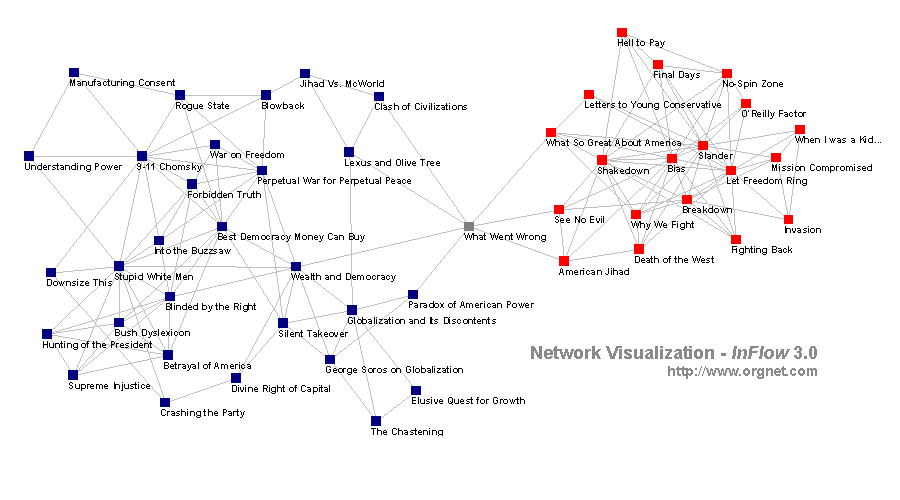Mapping What We Read
Adina writes about some informal research done by Valdis Krebs that resulted in this diagram, which you can see full size by clicking here or on this gargantuan thumbnail:

This is a rough-and-ready map of the reading preferences of the political left and the right. Valdis, who does superb maps of complex information, looked at some books easily identifiable as lefty or righty (e.g., Michael Moore’s Stupid White Men and Ann Coulter’s Slander) and then looked at each book’s “buddy list” (“People who bought this book also bought…”). He followed those links and mapped the results.
Given that Valdis is not pretending to have done thorough, systematic search, the results are nevertheless interesting if not surprising: We’re not reading one another’s books. In fact, Valdis found only one book that both “sides” are reading: Bernard Lewis’ What Went Wrong: Western Impact and Middle Eastern Response.
Valdis puts this diagram forward as the result of some back-of-the-envelope research and nothing more. It leaves me with two questions: Is this clustering getting tighter or looser? And where would we find common ground outside of books about politics? Are lefties and righties both reading Harry Potter, About a Boy or Amsterdam? Are we all keeping up with The Sopranos? And surely concerned citizens of all political persuasions set aside an hour on Tuesday night to watch Buffy!
I hope Valdis approaches Amazon and suggests that they use his tool to let us all see the emergent patterns…
Categories: Uncategorized dw










I’m surprised by the ‘left’ position of Samuel Huntington’s very conservative Clash of Civilizations. Given both its recent multiple bursts of high sales and the justifications it offers for much of the current administration’s policy, I wonder why it isn’t at least shared by both groups?
Which raises a problem with this kind of map: I have a copy of CoC, but I’ve used it to teach specifically against the conclusions Huntington draws. But intention doesn’t show up in a map, nor does actual usage–both parties may read a book, but for very different reasons and making very different meanings of it.
The map may not match your vision of things, but that is what the data tells us! Two books are connected if either of them were bought with the other. The books mapped are the ones where this buying behavior happened the most. The network was laid out using an algorithm that is driven by the pattern of connections. Two obvious cliques emerged. The nodes in each clique were then colored for easier reading by the non-trained eye.
Steve, you may read books that do not match your political orientation, but again, that is what the data tells us! Most on-line book purchasers in this space tend to choose books by authors with similar viewpoints.
I chose the word ‘problem’ injudiciously above: what I meant was that a map like this tells part of a story, and that it offers the chance to discover other parts.
I don’t doubt the accuracy of the data, I’m only surprised by some of them and would like to know more about what they mean. As you say, ‘Most on-line book purchasers in this space tend to choose books by authors with similar viewpoints’, and Clash of Civilizations doesn’t seem (to me and others) to have a similar viewpoint to the books it is grouped with. That offers a great jumping-off-point for more anecdotal and ethnographic research, and a chance to understand the readers behind the books.